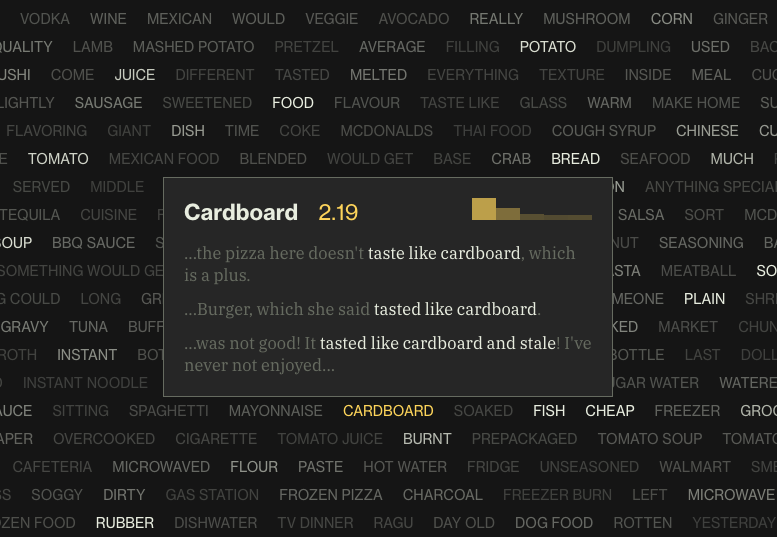

“Gourmandise is an act of our judgment, in obedience to which, we grant a preference to things which are agreeable, over those which have not that quality.”
— Jean Brillat-Savarin, 1825
“The crab legs were cold, and tasted like a wet bathing suit that had been balled up in a bag for three days. Everything sucked.”
— Yelp review of “Crazy Buffet”, 2011
Sometimes, the critiques are bizarre. A one-star review of a now-defunct Italian spot on the Vegas strip reprovingly notes that “the lion head fountain [in the restroom] has such a looooong tube coming out of his mouth.” Other times they border on hyperbole, like the takedown of an Ontario restaurant that begins with a warning to “run for your life!!”
But there might be more to those kinds of reviews than a penchant for melodrama. A 2014 study by Stanford linguist Dan Jurafsky found that the language used in negative reviews on sites like Yelp mimics the language used by victims recounting traumatic experiences, and that one-star reviews might act as a sort of coping mechanism for diners beset by the “minor trauma” they experienced at the hands of inattentive servers and inexperienced chefs.
That study, by the author of an interesting book I recently read, got me thinking about the language we use to describe food — both good and bad. How can we communicate what we like and dislike about the way something tastes in words that make sense to others?
To investigate, I downloaded a collection of more than 5 million Yelp reviews* and wrote a program to read through them and find all the passages where reviewers say a dish “tastes like” or “tasted like” something else (you can explore the results interactively here).

I quickly noticed some trends. Bad soups and sauces were disparagingly equated to the grocery store variety, and a troubling number of reviewers discussed whether or not their chicken dishes tasted like “real chicken” (I won’t ask what the implied alternative is here). Sometimes, reviewers made comparisons to things they almost certainly hadn’t tasted, like when the pizza from a Los Angeles shop was enthusiastically compared to “the pizza from Teenage Mutant Ninja Turtles.”
To try and quantify these trends, I extracted the words and phrases used in the descriptions and, for each word, averaged the “star” ratings for all the reviews it was used in. By doing this for every word, we can see which descriptions are consistently associated with good and bad food.
“The biggest takeaway here is that people seem to value, above all else, the perception of authenticity in their food.”
Some of the results were obvious. “Old grease”, “rubber”, “garbage”, and “vomit” were all among the 20 worst words out of the 524 I identified (I only looked at words and phrases used more than 50 times). More interesting, though, was the obvious disdain reviewers had for food they perceived as inauthentic or processed.
Comparisons to packaged food brands like Campbell’s, Ragu, and Chef Boyardee ranked lower than such obviously disgusting descriptions as “chlorine” and “cigarettes.” “T.V. dinner,” which was used in 64 reviews, was the sixth-worst phrase, coming in below “garbage” and “crap.”
The same trend can also be seen on the opposite end of the spectrum. Variations on “homemade”, “real”, and various feast-centric holidays made up the bulk of the most positive descriptors. Other positive words included American classics like “apple pie” and “funnel cake”, along with more abstract descriptions like “buttery” and “rich.”

Interpreting the words that didn’t have a strong positive or negative lean was less straightforward. Reviewers are apparently torn on their opinion of cough syrup, which averaged about 2.8 stars with a fairly high standard deviation. Similar uncertainty showed up for flavors like “cinnamon”, “alcohol”, and “pickles,” which all averaged between two and three stars but had some of the widest ranges of use.
It seems the biggest takeaway here is that people value, above all else, the perception of authenticity in their food. Sure, something might taste like “sock” or “cat food”, but it certainly shouldn’t taste like it came out of a can. And all the better if it reminds you of something grandma made when you were a kid.
This idea is similar to the results of another study by the same author of the paper and book mentioned earlier. He found that language on menus attesting to an item’s authenticity or provenance is correlated with the item’s price.
So even though the Anthony Bourdain called the word “authentic” a “completely ridiculous, snobbish term,” it seems that the implication of authenticity is still coveted by consumers. And according to these Yelp reviews, it also might play a big role in how much people enjoy a meal.
With all this in mind, I think the next time I go out for dinner I’ll order something rich and buttery — maybe a slice of apple pie.
* That 5 million included reviews of many businesses, not all related to food. The final set filtered down to reviews of restaurants that included the phrases “tastes like” or “tasted like” was about 100,000 reviews.
We’d love to hear what you’re working on, what you’re curious about, and what messy data problems we can help you solve. Drop us a line at hello@fathom.info, or you can subscribe to our newsletter for updates.